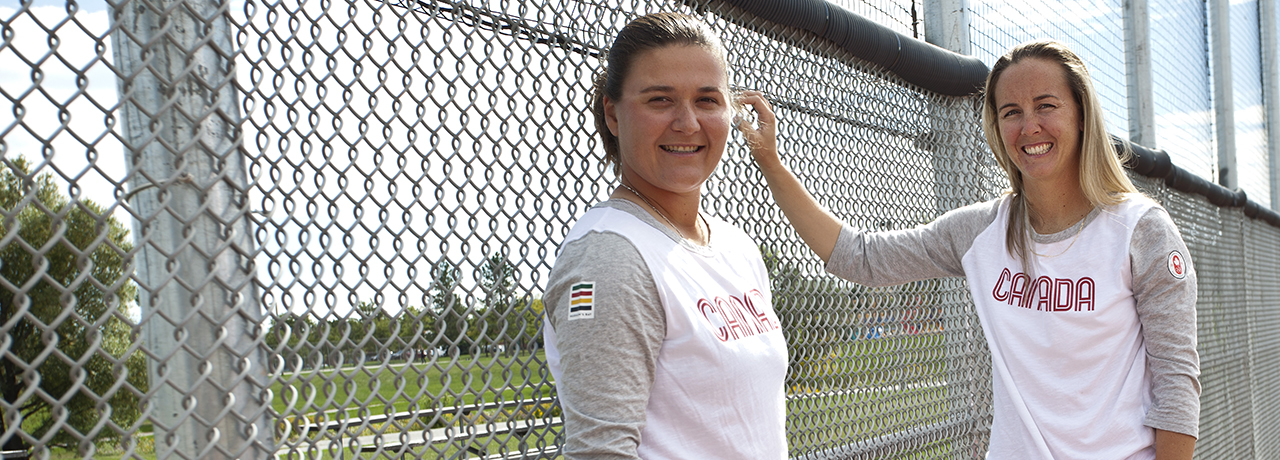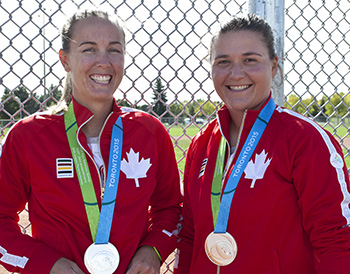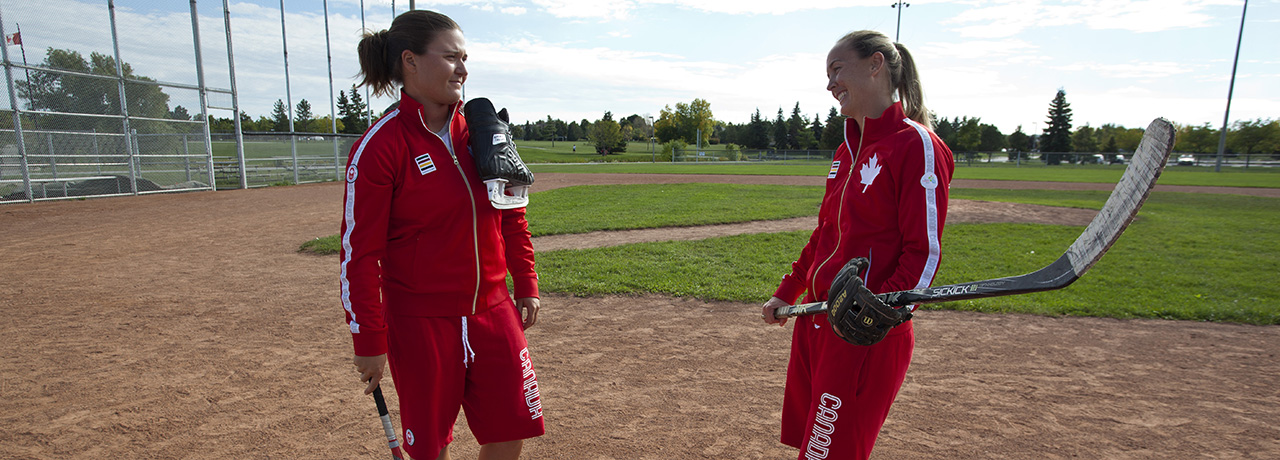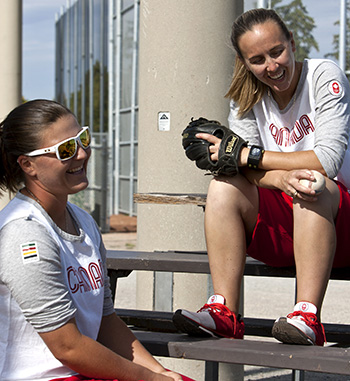
Photography by Nick Lachance
There aren’t many who have athletic resumés quite like Kate Psota’s or Ashley Stephenson’s. From silver medals at the Pan Am Games to multiple podium finishes at baseball World Cups to a bevy of national and provincial hardware from playing university hockey, the two Laurier alumni have had decorated careers both as Laurier Golden Hawk women’s hockey players and as members of Canada’s national women’s baseball team.
But as nice as it is to win medals and gain the kind of recognition that came with their historic appearance at the Toronto 2015 Pan Am Games, neither is the reason Psota (BSc ‘10) or Stephenson (BSc ‘05) got into baseball — or hockey, for that matter — in the first place. It’s also not why they continue today, balancing national team, provincial team and club team commitments with full-time jobs.
The reason, they say, is quite simple. “I just play every year because I love it,” says Stephenson. “I wish I had a better answer, but I’ve always just played because I loved it and I never, ever thought anything like this would happen.”
Adds Psota: “When I was 15 or 16, I played on three different teams in the same summer and my mom said to me, ‘The day you wake up and you’re not sure you want to keep doing this, then it’s time to stop.’ Here we are now and I’m still at it.”
Both women fell in love with baseball at early ages. Growing up in Mississauga, Stephenson’s baseball career began when she was four years old and her dad was asked to help coach a team of mostly boys. He agreed to help coach on the condition that his daughter could play. But there was one problem: “Everyone was supposed to be five, so my dad just lied,” laughs Stephenson. “But then he realized, ‘Oh man, she’s never touched a ball or a glove before!’”
Within a few games of catch in the backyard, Stephenson was hooked. She’s been a ballplayer ever since.
Psota, a Burlington native, remembers being obsessed with baseball from the time she was able to talk. No one in her family had played the game, but she couldn’t get enough. After a few years playing in all-girls and all-boys house leagues, she made a triple-a boys rep team at age nine and the bulk of every summer since has been spent on a baseball diamond.

Growing up in the heyday of the Toronto Blue Jays’ back-to-back World Series championships in 1992 and 1993, it wasn’t difficult for Psota or Stephenson to get swept up in baseball hysteria as kids. But while their male friends could grow up dreaming of playing Major League Baseball or even representing Canada in the Olympics — men’s baseball was included in the Summer Olympics until 2008 and is slated to return in 2020 — the same opportunities just didn’t exist for women.
“When we were kids there wasn’t even a Team Canada. We just played because this was really fun,” says Stephenson. “It’s not like my mom ever said ‘play so you can get a scholarship’ or anything like that.”
While opportunities for women’s baseball were limited when Psota and Stephenson were growing up, there was no shortage of opportunities for women who played softball. Softball was an Olympic sport from 1996-2008 — it will return in 2020 along with men’s baseball — and athletic scholarships to prestigious schools are plentiful in the sport. This has given rise to a common misconception that women only play softball and not baseball, something Psota and Stephenson are often correcting.
“We find ourselves explaining that our fields are the same as major league fields and there are women who can hit home runs, and yes, we throw curve balls,” says Psota.
Both Psota and Stephenson tried softball at different points of their youth, and while they hold no ill will towards the game, it wasn’t for them, regardless of what it might have led to. “I did have people telling me all the time, ‘There’s nothing for you after this, you should play softball,’” says Psota. “I played hockey and I knew that could be an avenue to get me to school and things like that. But that stuff wasn’t as important to me because I just loved baseball so much.
“There was never a point when we were younger where we could say ‘I aspire to do this or that,’ because there just wasn’t anything there.”
That changed in 2004 when Baseball Canada formed its senior women’s national team. After making it through regional tryouts, Psota and Stephenson were invited to a training camp in Montreal featuring the top 40 women baseball players from across Canada. They both made the final cut. Today they’re the only two members of that original team still on the roster.
Despite the growth of women’s baseball in Canada, from the depth of talent across the country to the visibility of the program, there simply isn’t the funding for baseball to be a full-time job. So on top of workouts, practices, games and tournaments — which can require travel to Asia, South America or across Canada — both Psota, who works full-time at a garden centre, and Stephenson, a phys ed teacher, hold down day jobs. While they admit it can be demanding, the sacrifices are well worth it.
“You just find ways to make it happen,” says Stephenson. “I haven’t taken a summer off baseball since I was four and honestly, I don’t know what I’d do with myself if I wasn’t playing.”
With all the progress women’s baseball has made in the 11 years since the Canada’s national team was formed, perhaps the most significant step came when the sport made its debut at the 2015 Pan Am Games in Toronto. This marked the first time women’s baseball had been included in a multi-sport event and the importance of exposure at that level was not lost on Psota and Stephenson.
“Obviously, our main goal was to win gold, but we wanted to show everyone that we’re good ballplayers and we’re here to stay,” says Stephenson, who, as the most senior member of the team, became an unofficial spokesperson during the Games. “We wanted to put on good baseball games, and that’s what we did. There weren’t blowouts, it was good baseball.”
Team Canada won every preliminary game they played aside from a tight 3-1 loss to the rival Americans, who they’d also lose to in the gold medal game. As is the competitive nature of elite athletes, Psota and Stephenson admit the silver medal was tough to swallow. But a few months after the Games, both can see the bigger picture.
“After the game I told the girls that in a year or two, maybe longer, we’ll look back and we’ll be proud of what we did,” says Stephenson. “We were only together for the Pan Am Games for a month, but we all worked so hard for years and years.”
Although the medal they came away with wasn’t the colour they were hoping for, Psota and Stephenson still count playing for Pan Am gold, and the entire experience of the Games as the highlights of their playing careers.

Aside from her Pan Am experience, Stephenson’s best sporting memory came in 2005 when she led Laurier’s women’s hockey team to the first — and still only — national hockey title in school history. A decade later, the former team captain and stalwart defender recalls every detail with ease.
“Going into that game, no one was giving us much of a chance,” she says of playing the vaunted University of Alberta Pandas, who at the time had won three-straight national titles and were riding an unbelievable multi-year winning streak. “But I just remember on the bus, Candice Djukic, one of our forwards, took her headphone out and said to me, ‘We’re winning this game.’ And I said, ‘You know what, I think so too. I’m not even nervous.’ And the whole bus was just calm, nobody seemed stressed.”
The Golden Hawks pulled off the remarkable upset with a 4-1 win. That 2004-05 team was inducted into the Golden Hawk Hall of Fame in 2014, while Stephenson — a two-time All-Canadian, six time provincial all-star, two-time team captain and MVP of the 2005 national championship — was inducted as an individual athlete in 2011. Psota arrived at Laurier the year after that national championship triumph, joining her teammate from the national baseball squad, as Stephenson returned for a fifth year in 2005-06.
While Psota didn’t win a national championship during her five-year Laurier career, she’s not short on hardware from her university days. The Golden Hawks won provincial gold every single season she was on the team, also winning three silvers and a bronze at nationals.

“As much as it was about hockey then — and it was definitely nice winning five OUA championships — looking back now I realize how special it all was,” Psota says of her time at Laurier. “You don’t realize the friends you’re making and the connections you’ll have for the rest of your life.”
When her Laurier career ended, Psota decided to stop playing hockey competitively, and focus on baseball, a decision she says was made a bit easier by an opportunity to spend the fall and winter of 2011 in Australia playing baseball, something she’s done twice since.
Stephenson followed up her Laurier career by playing in the early days of the National Women’s Hockey League (NWHL), now called the Canadian Women’s Hockey League (CWHL), also spending some time with Canada’s national women’s hockey team.
Though the CWHL covers travel and equipment expenses, players don’t draw a salary. So while playing hockey professionally, Stephenson started her teaching career; all while spending her summers playing baseball with the national team.
After seven seasons in the NWHL/CWHL, Stephenson was forced to retire from competitive hockey when she suffered her seventh concussion. She stays connected to the game, coaching the boys’ hockey team at her school and refereeing girls’ junior hockey, with the hope of working her way up to the university level.
Being involved in women’s hockey has given Psota and Stephenson a good barometer for how a sport can grow. The past 20 years has seen a substantial increase in the number of girls playing hockey around the world, particularly in Canada, growing the game at the grassroots level.
Many credit women’s hockey’s inclusion in the Winter Olympics for the first time in 1998 as the catalyst for this growth. Those involved with women’s baseball are hoping the 2015 PanAm Games can play a similar role. While it’s too soon to tell if this will be the case, the early signs are encouraging. “Multiple times at the Pan Ams, we had people coming up to us saying, ‘You just changed my daughter’s outlook on sports,” says Psota. “We really didn’t know what to say to that. We just put on our ‘ball stuff and start playing. You don’t really realize the impact it can have.
“Even if we can inspire a dozen little girls to get playing baseball, it’ll be an accomplishment.”
Another factor that might influence the growth of women’s baseball in Canada is the 2015 resurgence of the Toronto Blue Jays, who made the playoffs for the first time in 22 years. Baseball experienced a boom among boys and girls across Canada when the Blue Jays were dominant in the early 1990s and with a more encouraging climate for women in sports today, a second boom could have even more of an impact on young girls.
“You look at the Jays games right now, they’re full of young kids — girls and boys,” says Stephenson. “With the popularity of the sport in the country and now that there are those opportunities for girls, I think that could be huge.”
With the future of women’s baseball in Canada looking bright, Psota and Stephenson have started contemplating their own futures with the national team. Both are committed to playing in next year’s World Cup in South Korea, but haven’t looked too far beyond that. By then, Psota will be 30 and Stephenson 33. In sports terms, both know they’ll be closer to the ends of their careers than the beginning.
But much like what got them into the game in the first place, both say if they still love playing and can still contribute, they’ll keep showing up to the diamond, bats and gloves in hand.